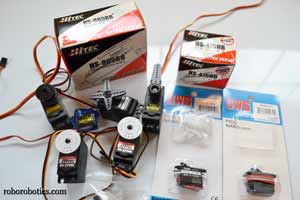Animatronics - Servo Motors
 Servo motors have been used more frequently in recent years to make animatronic figures move. Servo motors have been popular for a long time with radio control (RC) car and airplane hobbyists. Improved, low-cost control systems for servo motors and more durable internal gear systems also make servo motors more attractive to animatronic figure designers. In the past, servo motors were seen as only useful in a temporary animatronic figure. The life span was considered too short. Unless the figure was expected to run for a very short time, pneumatics, DC motors, or hydraulic systems typically took their place. The near-analog control of the servo motors, however, makes them very attractive.
Servo motors have been used more frequently in recent years to make animatronic figures move. Servo motors have been popular for a long time with radio control (RC) car and airplane hobbyists. Improved, low-cost control systems for servo motors and more durable internal gear systems also make servo motors more attractive to animatronic figure designers. In the past, servo motors were seen as only useful in a temporary animatronic figure. The life span was considered too short. Unless the figure was expected to run for a very short time, pneumatics, DC motors, or hydraulic systems typically took their place. The near-analog control of the servo motors, however, makes them very attractive.
![]()
Pneumatic cylinders are built to last. Their service life in typically in the millions of cycles. Servo motors, for a long time only enjoyed a service life in the tens of thousand cycles. Today, with improved composite and metal internal gears, some servo motors, if properly used, can last in the hundreds of thousands of cycles. From a practical standpoint, let's look at the numbers.
Let's say a servo in a figure cycles 6 times per minute
# cycles per hour = 6 x 60 = 360
# cycles per day (operating 12 hrs. per day) = 360 x 12 = 4320
If the servo has a life of 300,000 cycles, then
# days of servo life = 300,000 ÷ 4320 = about 69 days
As you can see, the use of short-life span servo motors in an animatronic figure operating for long periods of time every day is not ideal. In the least, easy access to replace servo motors is necessary.
Some servo motors have a life of more than 300,000 cycles, but it is not out of the ordinary for even a good servo motor to last only a few hundred thousand cycles. If a servo is used with cables that do not move freely, or with too much load, the life of the servo will drop dramatically. It is very important to minimize the load on a servo motor.
Additional Resources
How to Mount a Servo Motor
